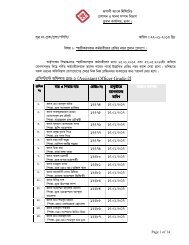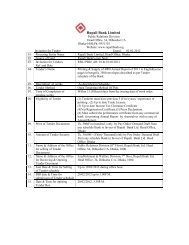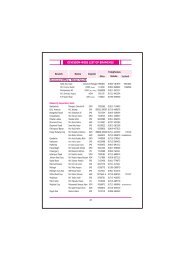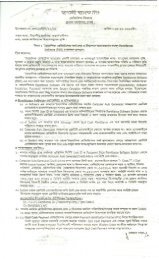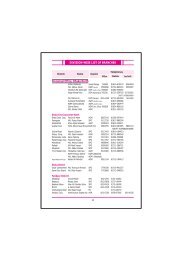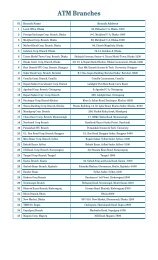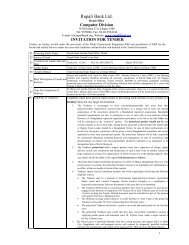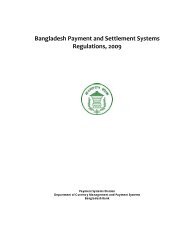Batch User Guide produced by CRIF - Janata Bank
Batch User Guide produced by CRIF - Janata Bank
Batch User Guide produced by CRIF - Janata Bank
Create successful ePaper yourself
Turn your PDF publications into a flip-book with our unique Google optimized e-Paper software.
Please note that the order in which the different rows appear does not matter, as long as they all<br />
correctly begin with the appropriate Record Type, and as long as the first row is the header and<br />
the last row is the footer.<br />
5.2.1 SPECIAL NOTES FOR THE REPORTING OF INSTALMENT CONTRACTS<br />
Instalment Contracts are Contracts where the financed amount is disbursed at once, but paid<br />
back through periodical partial payments, i.e. Instalments. Therefore, when looking at Instalment<br />
Contracts, we track the original financed amount (Total Financed Amount), the number of partial<br />
payments that will be paid during the life of the Contract as well as the value of each payment if<br />
these payments were to be done on a monthly basis for the life of the contract (to get an<br />
average value that can be compared across all Instalment loans), the number of Overdue and<br />
not Paid Instalments as well as the total Value of such Overdue and not Paid Instalments, and<br />
the number of Remaining Instalments (i.e. not yet paid, but also not overdue yet) as well as the<br />
total value of the amount that remains to be paid but is not Overdue yet. Naturally there must be<br />
consistency between these numbers. Therefore if we have a number equal to 0 (whether it‟s<br />
Total Number of Instalments, or of overdue instalments, or of remaining instalments), then the<br />
associated value must also be 0 (so for example we cannot have Number of Overdue<br />
Instalments=0, but value of Overdue Instlaments >0). At the same time, the total number of<br />
instalments must be equal to paid instalments, plus overdue and not paid instalments, plus<br />
remaining instalments. Therefore it follows that overdue and not paid instalments plus remaining<br />
instalment can never be more than total instalments.<br />
5.2.2 SPECIAL NOTES FOR THE REPORTING OF CREDIT CARD TYPE<br />
CONTRACTS<br />
Revolving credit lines and credit lines financed through the use of credit cards are those for which<br />
a credit limit is made available, to be used partially or in its entirety and also at different times,<br />
for the purchase of goods and services from participating retailers or for the attainment of funds<br />
availability. When the card is used during the reference period, the FI charges the customer the<br />
due amount (as a deferred payment) based on of the characteristics of the card.<br />
The FI must send information to CIB regarding every card credit report open on a data client‟s<br />
account that meets the contribution requirements which has the same debit and the same<br />
account statement. Therefore, if there are additional cards within the same card credit report or<br />
if the cards are used <strong>by</strong> other data clients which are different from the account signatory and<br />
everything is billed at the same time, the contribution to CIB is carried out only once in the name<br />
of the account signatory who is the client that assumes the risk for the purposes of CIB.<br />
As for all other credit lines client to contribution to CB, the reporting of credit card-type credit<br />
lines must also be carried out <strong>by</strong> the 5 th working day of the month subsequent to the reference<br />
month. When a card is used <strong>by</strong> the data client and is charged in the month of the monthly<br />
contribution to CIB, if the information regarding payment of this charge has not yet been<br />
received <strong>by</strong> the FI <strong>by</strong> the 5 th working day of the month, the contribution of the charge and the<br />
use of the card <strong>by</strong> the data client must be sent in the next month.<br />
5.2.3 SPECIAL NOTES FOR THE REPORTING OF NON INSTALMENT<br />
CONTRACTS<br />
Non Instalment Contracts are Contracts where a maximum financed amount (Credit Limit) is<br />
made available to the Subject, but not necessarily disbursed to the Subject. The Subject is then<br />
allowed to “draw down” from this amount up to the limit. The amount that at any one point is<br />
drawn down (including any accrued interest on it) is the Utilization of the credit. This is likely to<br />
vary repeatedly as any draw down from and payment to the credit will shift the Utilization<br />
accordingly. Therefore the amounts to be reported are the ones at the end of the reference<br />
month.<br />
35 of 92





